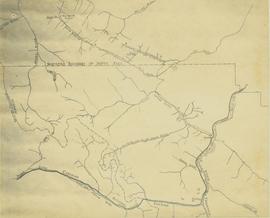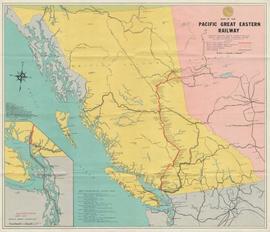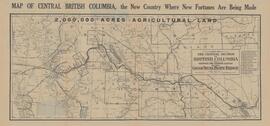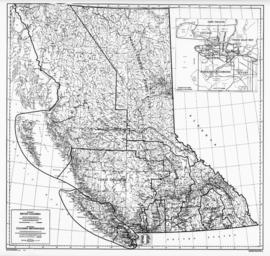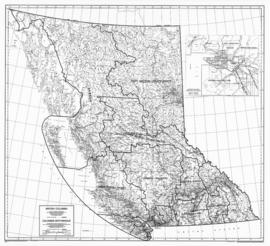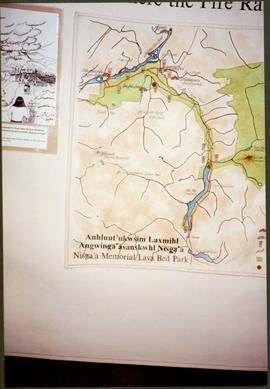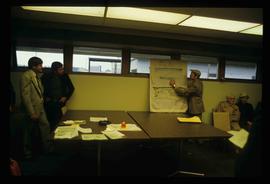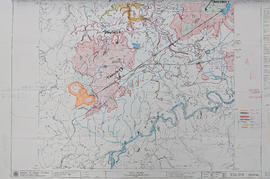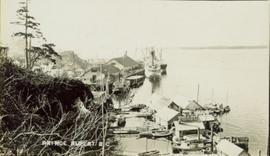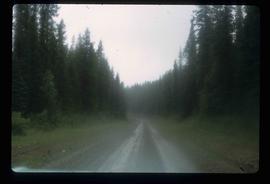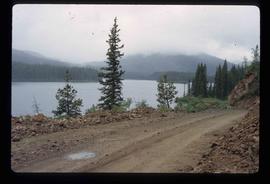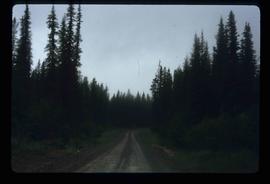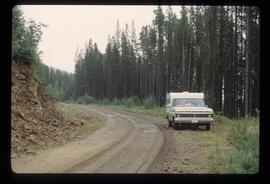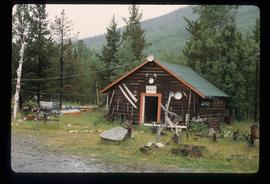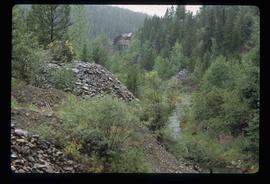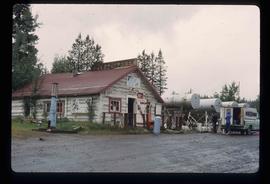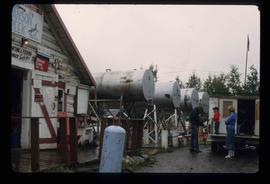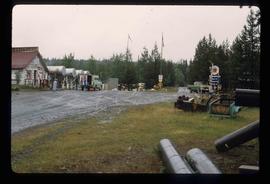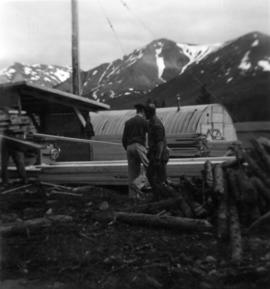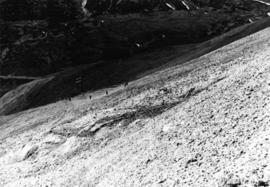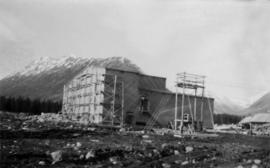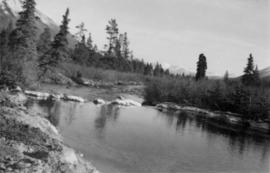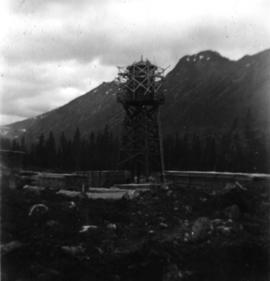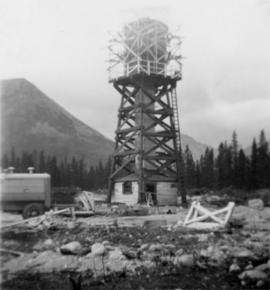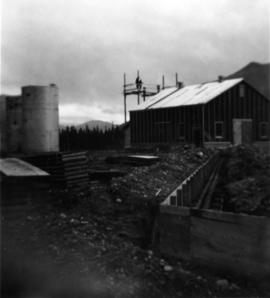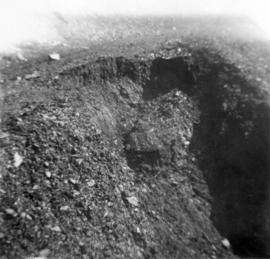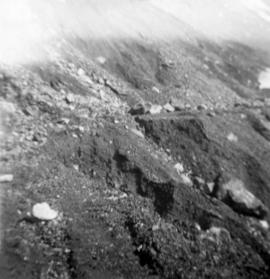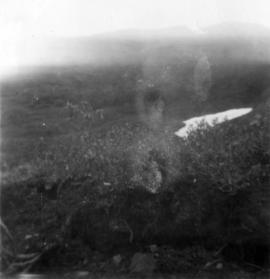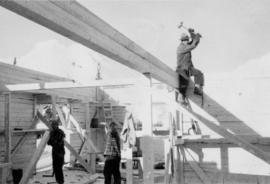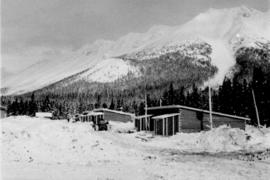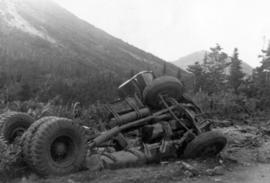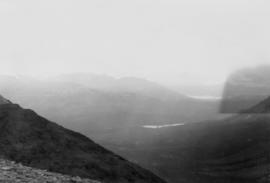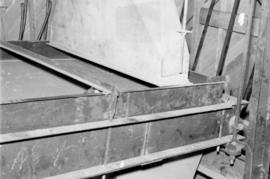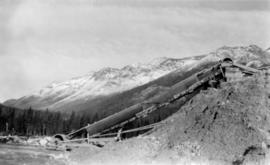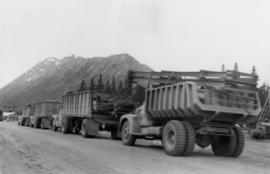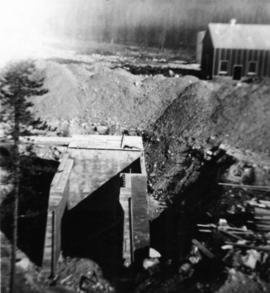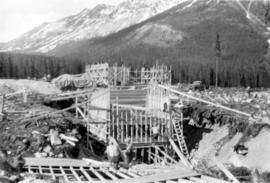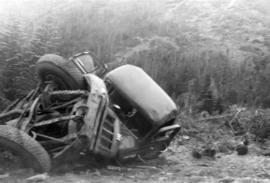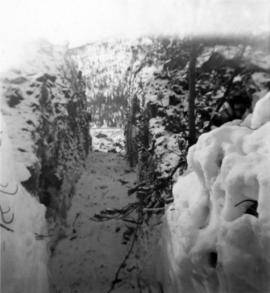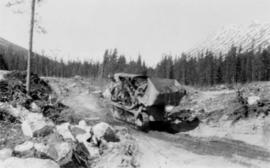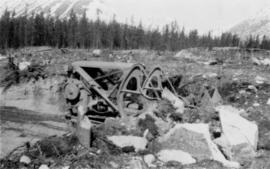Map depicts the rivers, railways, and select lakes and towns located at Jasper Park between the northern boundary of the park and the townsite of Jasper. Part of the border between Alberta and British Columbia is visible on the west of the map.
Map depicts the routes of the Pacific Great Eastern Railway, showing stations, railway connection, and the PGE Microwave Communication System.
Wyld, James. "Map of the Colony of New Caledonia and the British & American Territory West of the Rocky Mountains including Vancouvers Island and the Gold Fields" by James Wyld, Geographer to the Queen & the Prince Consort, Charing Cross East & 2 Royal Exchange, London, July 16, 1858.
Map reflects reserve boundary, roads, trails, 20 feet contour intervals, air photo centre, declination, swamps, and mile post at the Aleza Lake Forest Reserve.
Photograph depicts a map of the Prince George-Peace River district after the 1961 census.
Photograph depicts a map of the Prince George-Bulkley Valley district after the 1971 census.
Item is a map that distinguishes the regions covered by Tree Farm Licence No. 1 granted to Columbia Cellulose and Three Farm Licence No. 40 granted to Skeena Kraft. Major locations indicated in this map include: Prince Rupert, Terrace, Hazelton, Smithers, Kitimat, Skeena River, and Nass River. Railway routes are also shown.
Photograph depicts colour map displayed in unknown area, second poster semi-visible on left. See item 2008.3.1.22.34 for image believed to depict lava bed.
Image depicts a man holding up a board which appears to have maps of the Cottonwood Park on it.
Item is a photocopied map of the Aleza Lake area annotated to show transects.
Item is a reproduced map of Aleza Lake annotated to show a 1994 RFP study area.
Photograph of the Prince Rupert wharf. Many vessels are docked next to small buildings along the water. Annotation on recto reads: "Prince Rupert BC."
Image depicts the road to Manson Creek, B.C.
Image depicts the road to Manson Creek, B.C.
Image depicts the road to Manson Creek, B.C.
Image depicts the road to Manson Creek, B.C.
Image depicts the Omineca Museum in Manson Creek, B.C.
Image depicts a creek with a half collapsed shack in the background somewhere in Manson Creek. The slide is labelled "Manson workings."
Image depicts the gas station at Manson Creek, B.C.
Image depicts a man and his family filling up their truck with gas at Manson Creek, B.C.
Image depicts Manson Creek, B.C.
File consists of a speech given by Gary Runka to the Agricultural Institute of Canada entitled "Managing Our Land Resources for Survival and Pleasure".
Commentary on this speech by Barry Smith of the Ministry of Agriculture and Lands:
"This speech is aimed at land use planning and planners, and GGR provides his definition of "ecology" which includes:
"...the basic characteristics of the land - its geology, soils, climate, vegetation, and animal life, including the devil that does the most damage, man. It also includes the interrelationships within these basic characteristics and of course this is where the word "complexities" comes in. There are no two places where these components combine in exactly the same manner and each ecological unit, if you like, is unique."
GGR mentions the importance of considering options.
This package includes a copy of the speech as well as a second, 2 page document, with the same title in which GGR is noted as 'Manager of the BC Land Commission'. This second document is largely a summary of the more formal speech."
File consists of a speech given by Gary Runka entitled "Managing Conservation Lands to keep Nature's Pulse Beating" for the BC Trust for Public Lands.
Commentary on this speech by Barry Smith of the Ministry of Agriculture and Lands:
"GGR's was the opening address at the workshop. While this speech is focused on the issue of Best Management Practices (BMP), comments about the ALR are woven into the presentation. This copy of the speech appears to be a draft version and includes several hand-written amendments with some points crossed out.
In the opening, mention is made of the grounding that the 2008 document "Taking Nature's Pulse: the Status of Biodiversity in British Columbia" has provided the workshop.
This speech provides an historical overview of the broader provincial context of BMP's drawn from 40 years of GGR's experience. The following is a selection of his comments:
- BMP's are part of the "tool kit" of policy and management mechanisms that have been experimented with over the decades to try to rationalize human economic activities with the needs of other species and overall ecosystem well-being.
- Historically the 1960s and 70s Canada Land Inventory program that emerged from the Resources for Tomorrow conferences was a significant benchmark mapping land capability for agriculture, forestry, recreation, wildlife and waterfowl use (of which GGR was centrally involved).
- Within BC, using the CLI, the 1973 Land Commission Act authorized the establishment of a provincial zone to protect those sacred lands with the biophysical capability to grow food.
One point was not used in the speech (crossed out). The speaking notes, however, include a reference to the Land Commission legislation originally having a complimentary conservation objective that had since been removed. GGR makes the point that still having the conservation function may have contributed positively to current struggles to preserve natural habitat. Regardless, it is noted that the concept of the ALR has been a unique, effective and, most importantly a lasting management practices tool for conserving lands identified as biophysically significant.
A further selection of points made:
- We need to evolve BMP tools that are adaptable yet resilient in the face of changing knowledge, climate change and ever-evolving social priorities.
- Traditionally, planning has been most associated with local governments in the form of official community, regional and neighbourhood plans and as an outgrowth of the ALR - Agricultural Area Plans.
- Environment Farm Planning - by agreeing to engage in the conservation planning process, participating farmers and ranchers have qualified for funding to carry out farm improvements benefitting conservation and biodiversity.
- The work of the Delta Farmland and Wildlife Trust is outlined (p. 8)
- "My final words of wisdom are - Be focused and be pragmatic"
- "Many of the best intentions to standardize land management practices for conservation lands have been great on paper - but never quite make it on the ground."
- And, if BMP are not implemented effectively on the ground, they cannot play the critical role they need to play in 'keeping nature's pulse beating'."
Photograph depicts two men in plant site, mountains in background. Corresponding note on accompanying photo description page: "Pictures taken July 3rd, 1952. 3. Quonset warehouse in background. Temporary set-up for circular saw in foreground."
Photograph depicts four unknown animals in distance on mountain slope, valley in background.
Photograph depicts a mill with scaffolding on the left side of the building. A second scaffolding structure is in the foreground with trees and mountains in background. Typed annotation taped to verso of page stapled to photographs: "View of mill building looking west."
Photograph depicts body of water in mountain valley, trees surrounding.
Photograph depicts water tower. Piles of building material in foreground, trees and mountains in background. Corresponding note on accompanying photo description page: "Pictures taken July 17th, 1952: 12. Water tower nearly completed. Piping job underway. Looking northwest."
Photograph depicts tower, small building in base. Vehicle on left, trees and mountains in background. Corresponding note on accompanying photo description page: "July 26th: (6) Water tank & tower."
Photograph depicts pipes laid in ground on wood structure, power house and men on scaffold in background. Building materials on left in foreground. Corresponding note on accompanying photo description page: "August 20th: 7. Installing water pipes from water tank to Power House. Oil tanks on left. Looking southeast."
Photograph depicts dirt in washout on mountainside. Corresponding note on accompanying photo description page: "5. Wash-out past 3rd switchback."
Photograph depicts washed-out areas on mountainside. Corresponding note on accompanying photo description page: "3. Wash-out above road just past 1st switchback. There was no indication of any water running here before."
Photograph depicts dirt area. Shrubs, snow-covered area, and mountains in background. Corresponding note on accompanying photo description page: "6. Wash-out and rock slide in second gully containing snow."
Handwritten annotation in blue ink on recto of photograph: "Warehouse in construction." Photograph depicts two men working in warehouse interior, and one man sitting on top of wall with sledge hammer raised. Miscellaneous building tools and supplies throughout.
Handwritten annotation in blue ink on recto of photograph: "Foreground warehouse under construction and in the background lays asbestos." Photograph depicts two men walking towards warehouse building. Walls are erected though roof is not. Steel drums and equipment under tarp shelter in foreground, trees and mountaintops in background.
Photograph depicts crushed vehicle in wooded area, mountains in background.
Photograph depicts valley and mountain range, speculated to be the Cassiar valley.
Photograph depicts equipment believed to be in the concentrator, dryer, or mill building. Typed annotation taped to verso of page stapled to photograph: "Close-up of vacuum hood which sucks fibre away from the rock."
Photograph depicts unknown structure propped against side of dirt hill and believed to be in plant site. Structure speculated to be a chute or conveyor belt. Trees and mountains in background.
Photograph depicts four large trucks hauling miscellaneous material on road. Mountain in background, believed to be Cassiar area.
Photograph depicts ore truck being loaded at chute, road in foreground, man on right. Corresponding note on accompanying photo description page: "August 5th: 8. Loading truck from chute on top of mountain."
Photograph depicts concrete walls in ground, building materials on right. Corresponding note on accompanying photo description page: "August 25th: 10. Concrete walls for truck dump and coal handling bin. Power house in background. Looking north from mill roof."
Photograph depicts men building truck dump in foreground, building believed to be power house in background. Corresponding note on accompanying photo description page: "Pictures taken June 11th: (3) Framing water tank tower. Water well in foreground and tower timbers and oil tanks in background. Looking east." [Note believed to be incorrect.]
Photograph depicts men building framework for truck dump. Truck and mountains in background. Power house framework believed to be in background.
Photograph depicts crushed vehicle in wooded area.
Photograph was taken facing down a narrow, snowy trench, mountain base visible at end. Corresponding note on accompanying photo description page: "1. Trench through snow banks at mill site. We had to dig these trenches to facilitate surveying the mill foundations."
Photograph depicts track loader moving dirt in semi-cleared area. Trees and mountains in background.
Photograph depicts track loader moving dirt in cleared area. It is believed that the loader may have been excavating area for ore haul truck dump (see item 2000.1.1.2.222). Trees and mountains in background.
